Analyzing the Pros and Cons of the Cold War on the United States
VerifiedAdded on 2022/07/28
|5
|970
|15
Essay
AI Summary
This essay explores the profound impact of the Cold War on the United States, examining both the advantages and disadvantages it presented. It highlights how the Cold War facilitated economic growth, enabling the U.S. to overcome the repercussions of the Great Depression by fostering trade and rebuilding Western nations. The essay also addresses the cultural and political consequences, including the pervasive fear of communism and nuclear annihilation, leading to a state of constant nuclear preparedness among Americans. Despite the economic progress and policy development, the essay concludes that the Cold War also fostered distrust and insecurity within American society, underscoring its complex legacy.
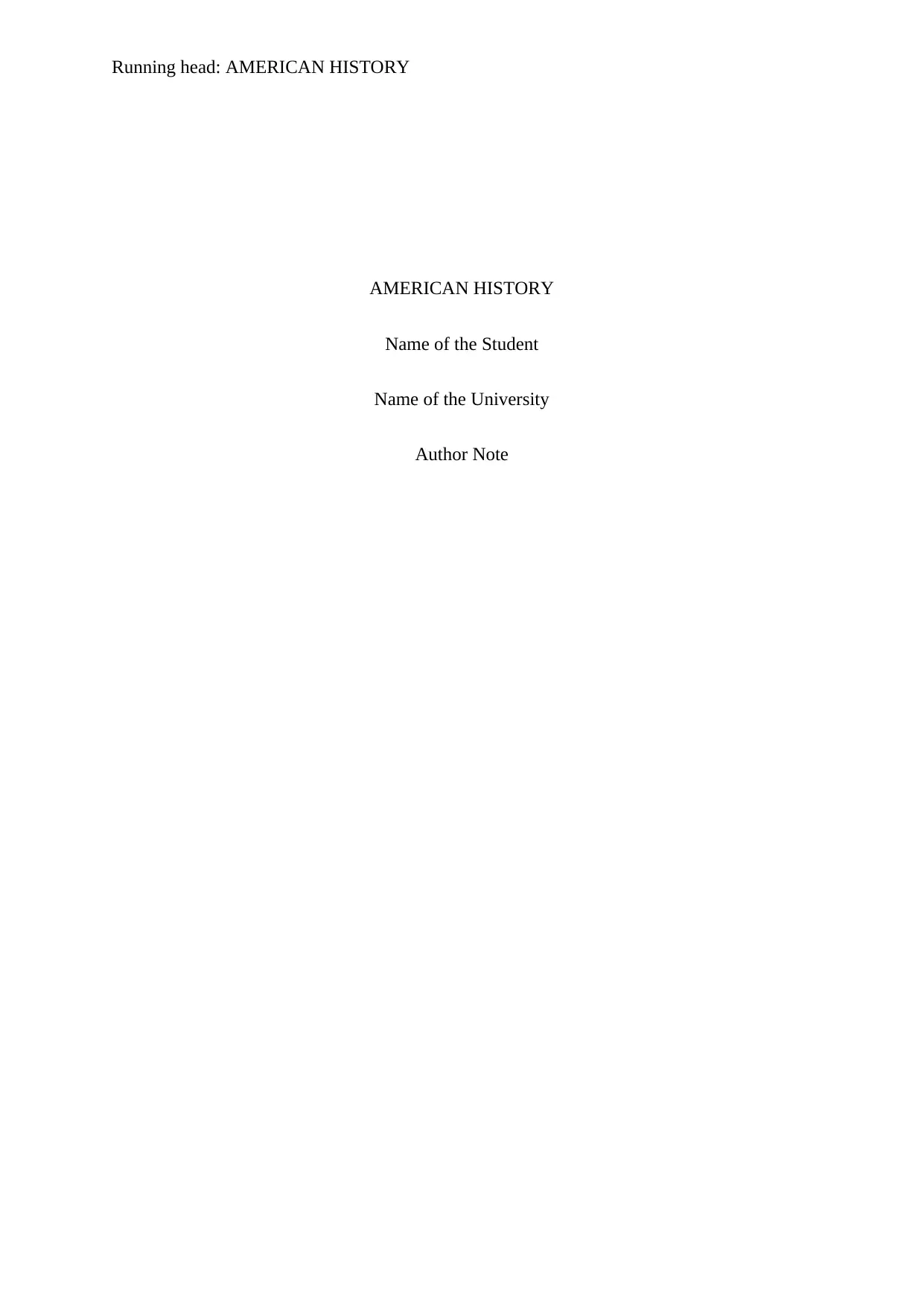
Running head: AMERICAN HISTORY
AMERICAN HISTORY
Name of the Student
Name of the University
Author Note
AMERICAN HISTORY
Name of the Student
Name of the University
Author Note
Paraphrase This Document
Need a fresh take? Get an instant paraphrase of this document with our AI Paraphraser
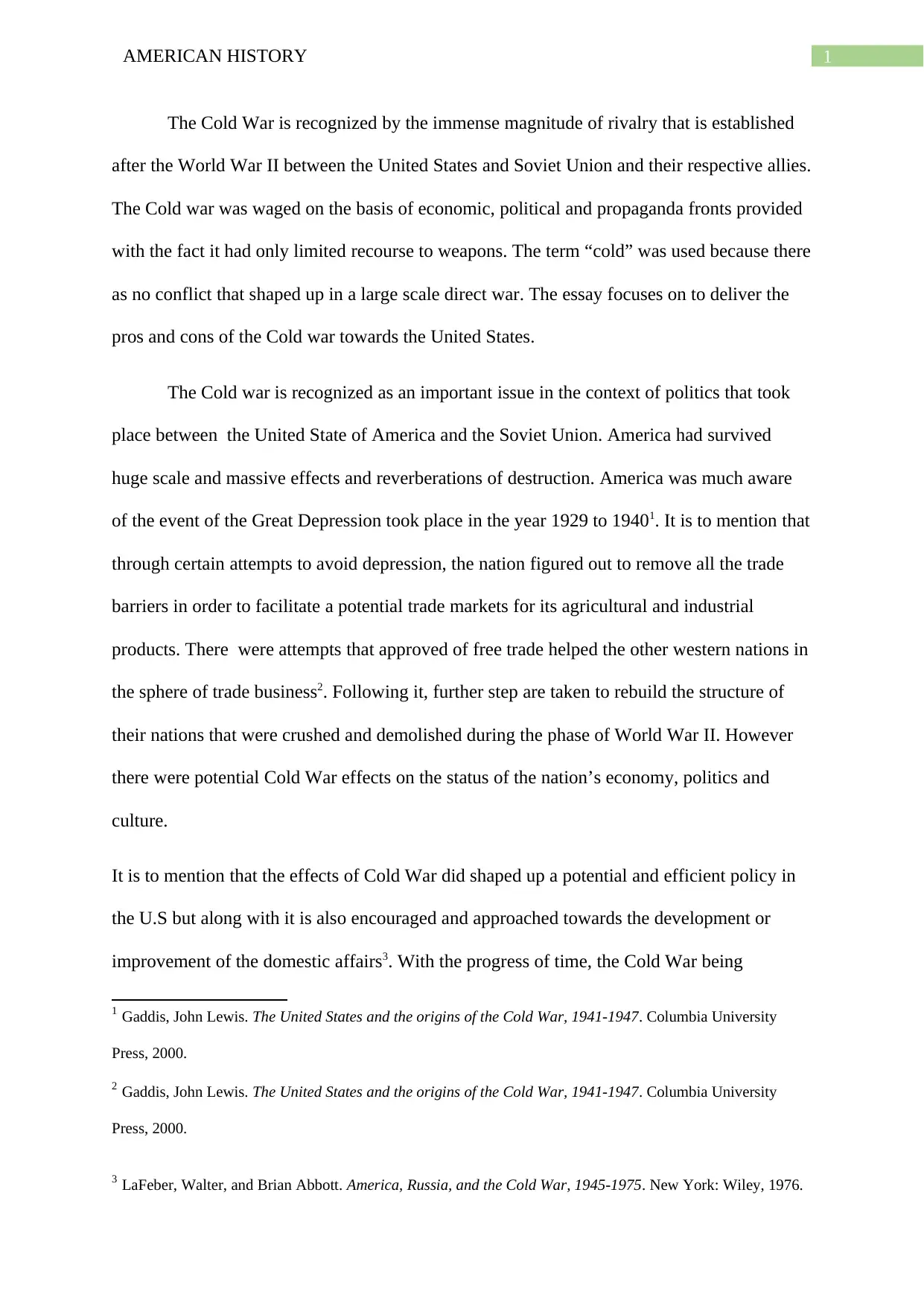
1AMERICAN HISTORY
The Cold War is recognized by the immense magnitude of rivalry that is established
after the World War II between the United States and Soviet Union and their respective allies.
The Cold war was waged on the basis of economic, political and propaganda fronts provided
with the fact it had only limited recourse to weapons. The term “cold” was used because there
as no conflict that shaped up in a large scale direct war. The essay focuses on to deliver the
pros and cons of the Cold war towards the United States.
The Cold war is recognized as an important issue in the context of politics that took
place between the United State of America and the Soviet Union. America had survived
huge scale and massive effects and reverberations of destruction. America was much aware
of the event of the Great Depression took place in the year 1929 to 19401. It is to mention that
through certain attempts to avoid depression, the nation figured out to remove all the trade
barriers in order to facilitate a potential trade markets for its agricultural and industrial
products. There were attempts that approved of free trade helped the other western nations in
the sphere of trade business2. Following it, further step are taken to rebuild the structure of
their nations that were crushed and demolished during the phase of World War II. However
there were potential Cold War effects on the status of the nation’s economy, politics and
culture.
It is to mention that the effects of Cold War did shaped up a potential and efficient policy in
the U.S but along with it is also encouraged and approached towards the development or
improvement of the domestic affairs3. With the progress of time, the Cold War being
1 Gaddis, John Lewis. The United States and the origins of the Cold War, 1941-1947. Columbia University
Press, 2000.
2 Gaddis, John Lewis. The United States and the origins of the Cold War, 1941-1947. Columbia University
Press, 2000.
3 LaFeber, Walter, and Brian Abbott. America, Russia, and the Cold War, 1945-1975. New York: Wiley, 1976.
The Cold War is recognized by the immense magnitude of rivalry that is established
after the World War II between the United States and Soviet Union and their respective allies.
The Cold war was waged on the basis of economic, political and propaganda fronts provided
with the fact it had only limited recourse to weapons. The term “cold” was used because there
as no conflict that shaped up in a large scale direct war. The essay focuses on to deliver the
pros and cons of the Cold war towards the United States.
The Cold war is recognized as an important issue in the context of politics that took
place between the United State of America and the Soviet Union. America had survived
huge scale and massive effects and reverberations of destruction. America was much aware
of the event of the Great Depression took place in the year 1929 to 19401. It is to mention that
through certain attempts to avoid depression, the nation figured out to remove all the trade
barriers in order to facilitate a potential trade markets for its agricultural and industrial
products. There were attempts that approved of free trade helped the other western nations in
the sphere of trade business2. Following it, further step are taken to rebuild the structure of
their nations that were crushed and demolished during the phase of World War II. However
there were potential Cold War effects on the status of the nation’s economy, politics and
culture.
It is to mention that the effects of Cold War did shaped up a potential and efficient policy in
the U.S but along with it is also encouraged and approached towards the development or
improvement of the domestic affairs3. With the progress of time, the Cold War being
1 Gaddis, John Lewis. The United States and the origins of the Cold War, 1941-1947. Columbia University
Press, 2000.
2 Gaddis, John Lewis. The United States and the origins of the Cold War, 1941-1947. Columbia University
Press, 2000.
3 LaFeber, Walter, and Brian Abbott. America, Russia, and the Cold War, 1945-1975. New York: Wiley, 1976.
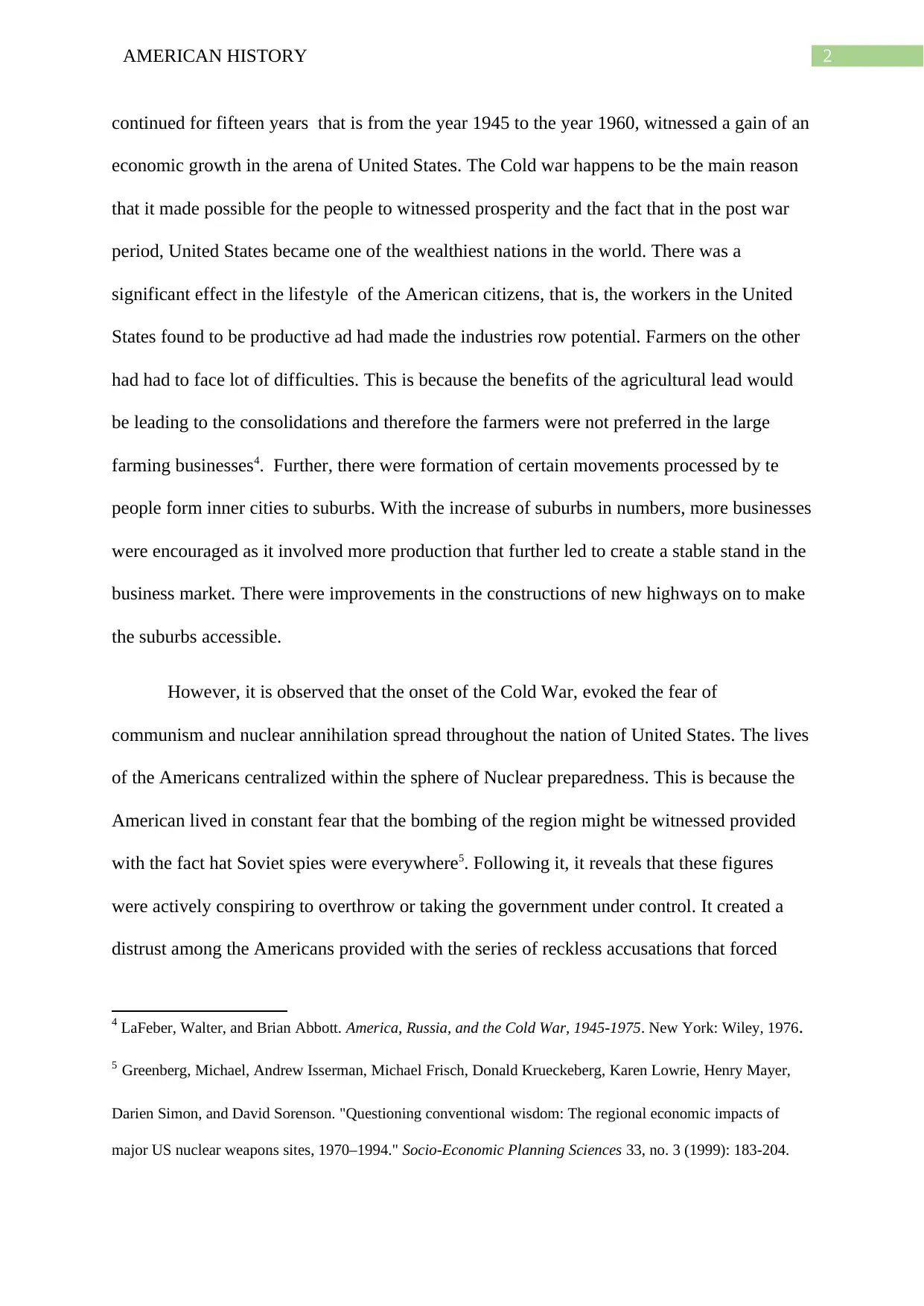
2AMERICAN HISTORY
continued for fifteen years that is from the year 1945 to the year 1960, witnessed a gain of an
economic growth in the arena of United States. The Cold war happens to be the main reason
that it made possible for the people to witnessed prosperity and the fact that in the post war
period, United States became one of the wealthiest nations in the world. There was a
significant effect in the lifestyle of the American citizens, that is, the workers in the United
States found to be productive ad had made the industries row potential. Farmers on the other
had had to face lot of difficulties. This is because the benefits of the agricultural lead would
be leading to the consolidations and therefore the farmers were not preferred in the large
farming businesses4. Further, there were formation of certain movements processed by te
people form inner cities to suburbs. With the increase of suburbs in numbers, more businesses
were encouraged as it involved more production that further led to create a stable stand in the
business market. There were improvements in the constructions of new highways on to make
the suburbs accessible.
However, it is observed that the onset of the Cold War, evoked the fear of
communism and nuclear annihilation spread throughout the nation of United States. The lives
of the Americans centralized within the sphere of Nuclear preparedness. This is because the
American lived in constant fear that the bombing of the region might be witnessed provided
with the fact hat Soviet spies were everywhere5. Following it, it reveals that these figures
were actively conspiring to overthrow or taking the government under control. It created a
distrust among the Americans provided with the series of reckless accusations that forced
4 LaFeber, Walter, and Brian Abbott. America, Russia, and the Cold War, 1945-1975. New York: Wiley, 1976.
5 Greenberg, Michael, Andrew Isserman, Michael Frisch, Donald Krueckeberg, Karen Lowrie, Henry Mayer,
Darien Simon, and David Sorenson. "Questioning conventional wisdom: The regional economic impacts of
major US nuclear weapons sites, 1970–1994." Socio-Economic Planning Sciences 33, no. 3 (1999): 183-204.
continued for fifteen years that is from the year 1945 to the year 1960, witnessed a gain of an
economic growth in the arena of United States. The Cold war happens to be the main reason
that it made possible for the people to witnessed prosperity and the fact that in the post war
period, United States became one of the wealthiest nations in the world. There was a
significant effect in the lifestyle of the American citizens, that is, the workers in the United
States found to be productive ad had made the industries row potential. Farmers on the other
had had to face lot of difficulties. This is because the benefits of the agricultural lead would
be leading to the consolidations and therefore the farmers were not preferred in the large
farming businesses4. Further, there were formation of certain movements processed by te
people form inner cities to suburbs. With the increase of suburbs in numbers, more businesses
were encouraged as it involved more production that further led to create a stable stand in the
business market. There were improvements in the constructions of new highways on to make
the suburbs accessible.
However, it is observed that the onset of the Cold War, evoked the fear of
communism and nuclear annihilation spread throughout the nation of United States. The lives
of the Americans centralized within the sphere of Nuclear preparedness. This is because the
American lived in constant fear that the bombing of the region might be witnessed provided
with the fact hat Soviet spies were everywhere5. Following it, it reveals that these figures
were actively conspiring to overthrow or taking the government under control. It created a
distrust among the Americans provided with the series of reckless accusations that forced
4 LaFeber, Walter, and Brian Abbott. America, Russia, and the Cold War, 1945-1975. New York: Wiley, 1976.
5 Greenberg, Michael, Andrew Isserman, Michael Frisch, Donald Krueckeberg, Karen Lowrie, Henry Mayer,
Darien Simon, and David Sorenson. "Questioning conventional wisdom: The regional economic impacts of
major US nuclear weapons sites, 1970–1994." Socio-Economic Planning Sciences 33, no. 3 (1999): 183-204.
⊘ This is a preview!⊘
Do you want full access?
Subscribe today to unlock all pages.

Trusted by 1+ million students worldwide
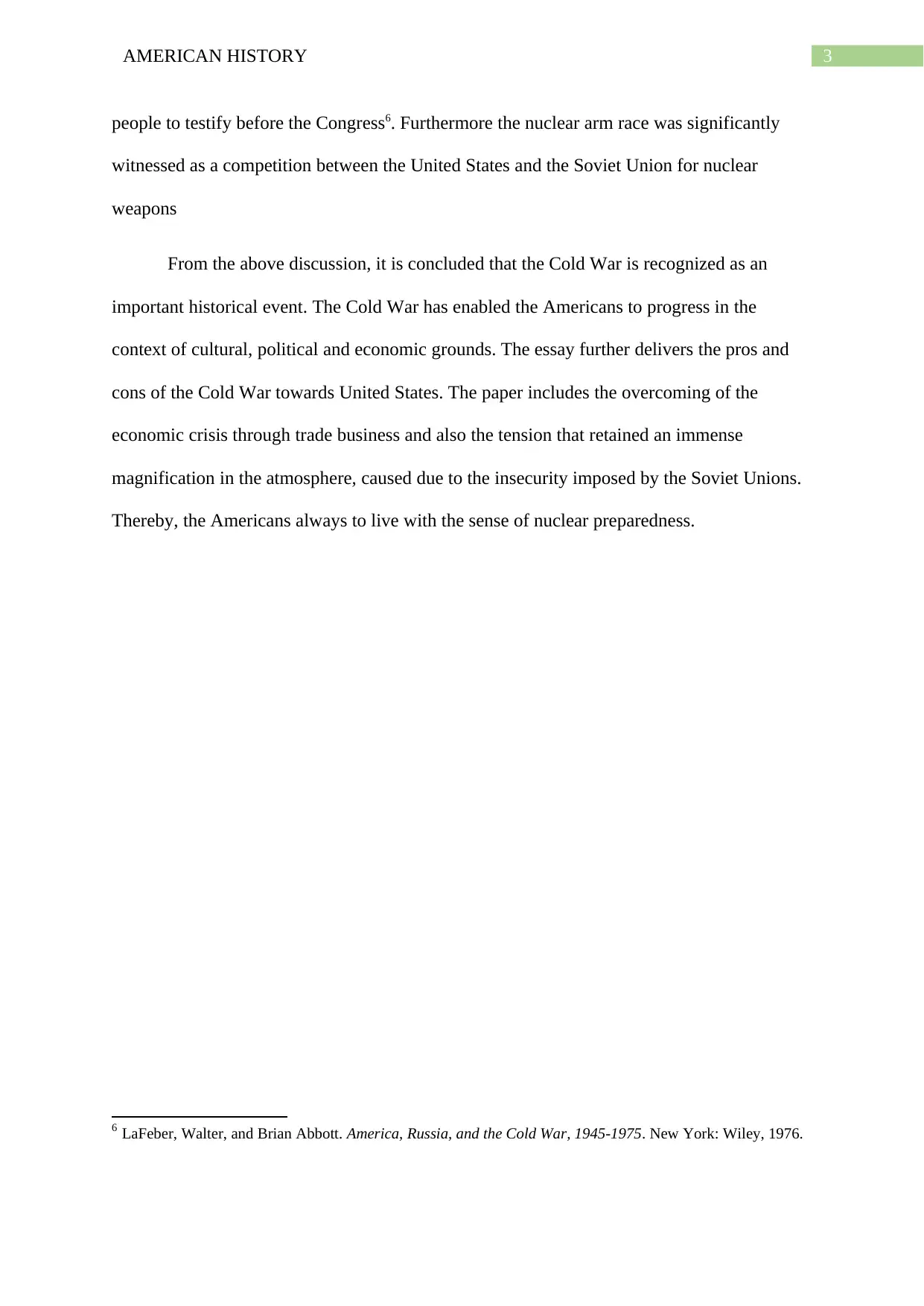
3AMERICAN HISTORY
people to testify before the Congress6. Furthermore the nuclear arm race was significantly
witnessed as a competition between the United States and the Soviet Union for nuclear
weapons
From the above discussion, it is concluded that the Cold War is recognized as an
important historical event. The Cold War has enabled the Americans to progress in the
context of cultural, political and economic grounds. The essay further delivers the pros and
cons of the Cold War towards United States. The paper includes the overcoming of the
economic crisis through trade business and also the tension that retained an immense
magnification in the atmosphere, caused due to the insecurity imposed by the Soviet Unions.
Thereby, the Americans always to live with the sense of nuclear preparedness.
6 LaFeber, Walter, and Brian Abbott. America, Russia, and the Cold War, 1945-1975. New York: Wiley, 1976.
people to testify before the Congress6. Furthermore the nuclear arm race was significantly
witnessed as a competition between the United States and the Soviet Union for nuclear
weapons
From the above discussion, it is concluded that the Cold War is recognized as an
important historical event. The Cold War has enabled the Americans to progress in the
context of cultural, political and economic grounds. The essay further delivers the pros and
cons of the Cold War towards United States. The paper includes the overcoming of the
economic crisis through trade business and also the tension that retained an immense
magnification in the atmosphere, caused due to the insecurity imposed by the Soviet Unions.
Thereby, the Americans always to live with the sense of nuclear preparedness.
6 LaFeber, Walter, and Brian Abbott. America, Russia, and the Cold War, 1945-1975. New York: Wiley, 1976.
Paraphrase This Document
Need a fresh take? Get an instant paraphrase of this document with our AI Paraphraser
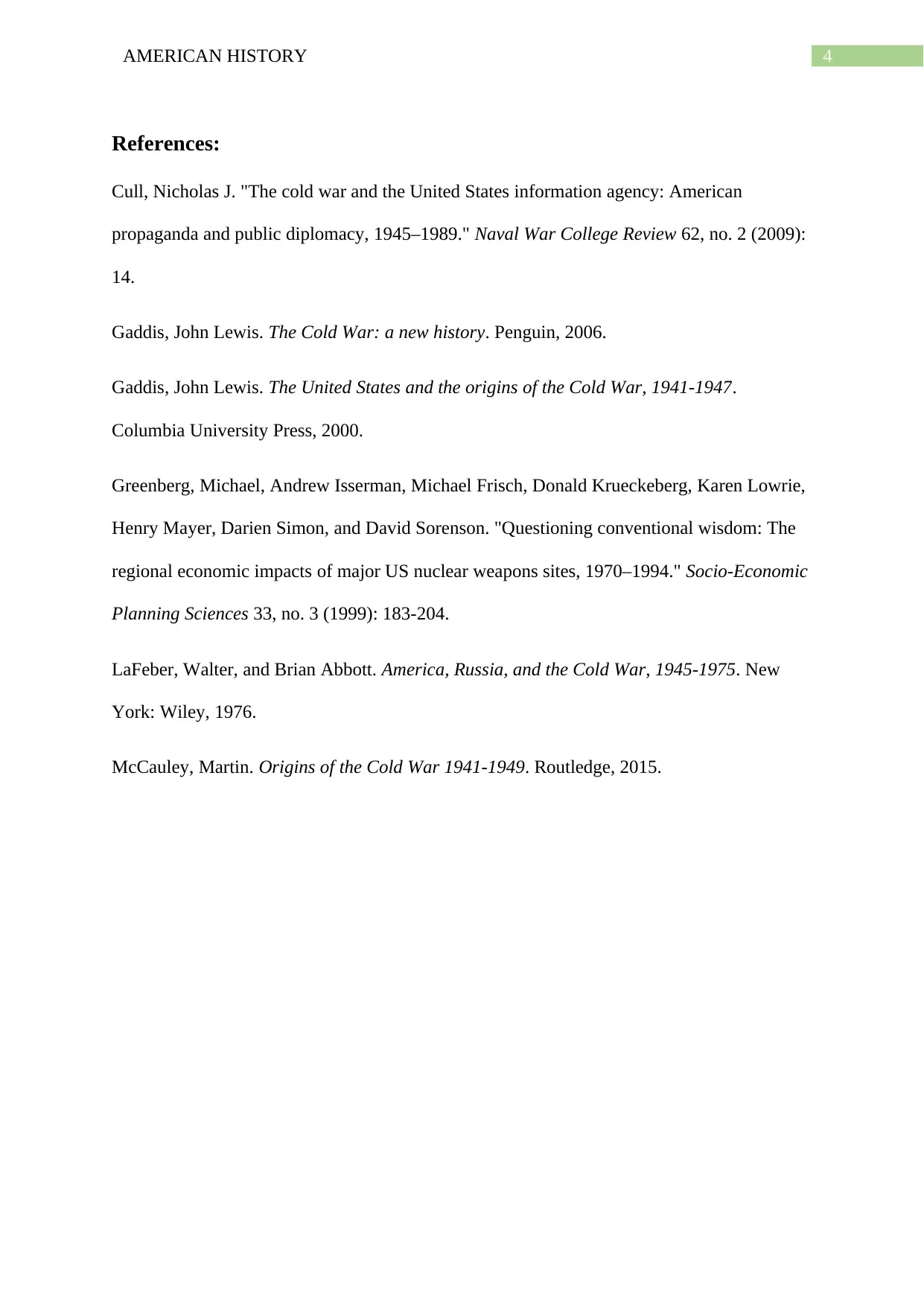
4AMERICAN HISTORY
References:
Cull, Nicholas J. "The cold war and the United States information agency: American
propaganda and public diplomacy, 1945–1989." Naval War College Review 62, no. 2 (2009):
14.
Gaddis, John Lewis. The Cold War: a new history. Penguin, 2006.
Gaddis, John Lewis. The United States and the origins of the Cold War, 1941-1947.
Columbia University Press, 2000.
Greenberg, Michael, Andrew Isserman, Michael Frisch, Donald Krueckeberg, Karen Lowrie,
Henry Mayer, Darien Simon, and David Sorenson. "Questioning conventional wisdom: The
regional economic impacts of major US nuclear weapons sites, 1970–1994." Socio-Economic
Planning Sciences 33, no. 3 (1999): 183-204.
LaFeber, Walter, and Brian Abbott. America, Russia, and the Cold War, 1945-1975. New
York: Wiley, 1976.
McCauley, Martin. Origins of the Cold War 1941-1949. Routledge, 2015.
References:
Cull, Nicholas J. "The cold war and the United States information agency: American
propaganda and public diplomacy, 1945–1989." Naval War College Review 62, no. 2 (2009):
14.
Gaddis, John Lewis. The Cold War: a new history. Penguin, 2006.
Gaddis, John Lewis. The United States and the origins of the Cold War, 1941-1947.
Columbia University Press, 2000.
Greenberg, Michael, Andrew Isserman, Michael Frisch, Donald Krueckeberg, Karen Lowrie,
Henry Mayer, Darien Simon, and David Sorenson. "Questioning conventional wisdom: The
regional economic impacts of major US nuclear weapons sites, 1970–1994." Socio-Economic
Planning Sciences 33, no. 3 (1999): 183-204.
LaFeber, Walter, and Brian Abbott. America, Russia, and the Cold War, 1945-1975. New
York: Wiley, 1976.
McCauley, Martin. Origins of the Cold War 1941-1949. Routledge, 2015.
1 out of 5
Related Documents
Your All-in-One AI-Powered Toolkit for Academic Success.
+13062052269
info@desklib.com
Available 24*7 on WhatsApp / Email
![[object Object]](/_next/static/media/star-bottom.7253800d.svg)
Unlock your academic potential
Copyright © 2020–2025 A2Z Services. All Rights Reserved. Developed and managed by ZUCOL.





